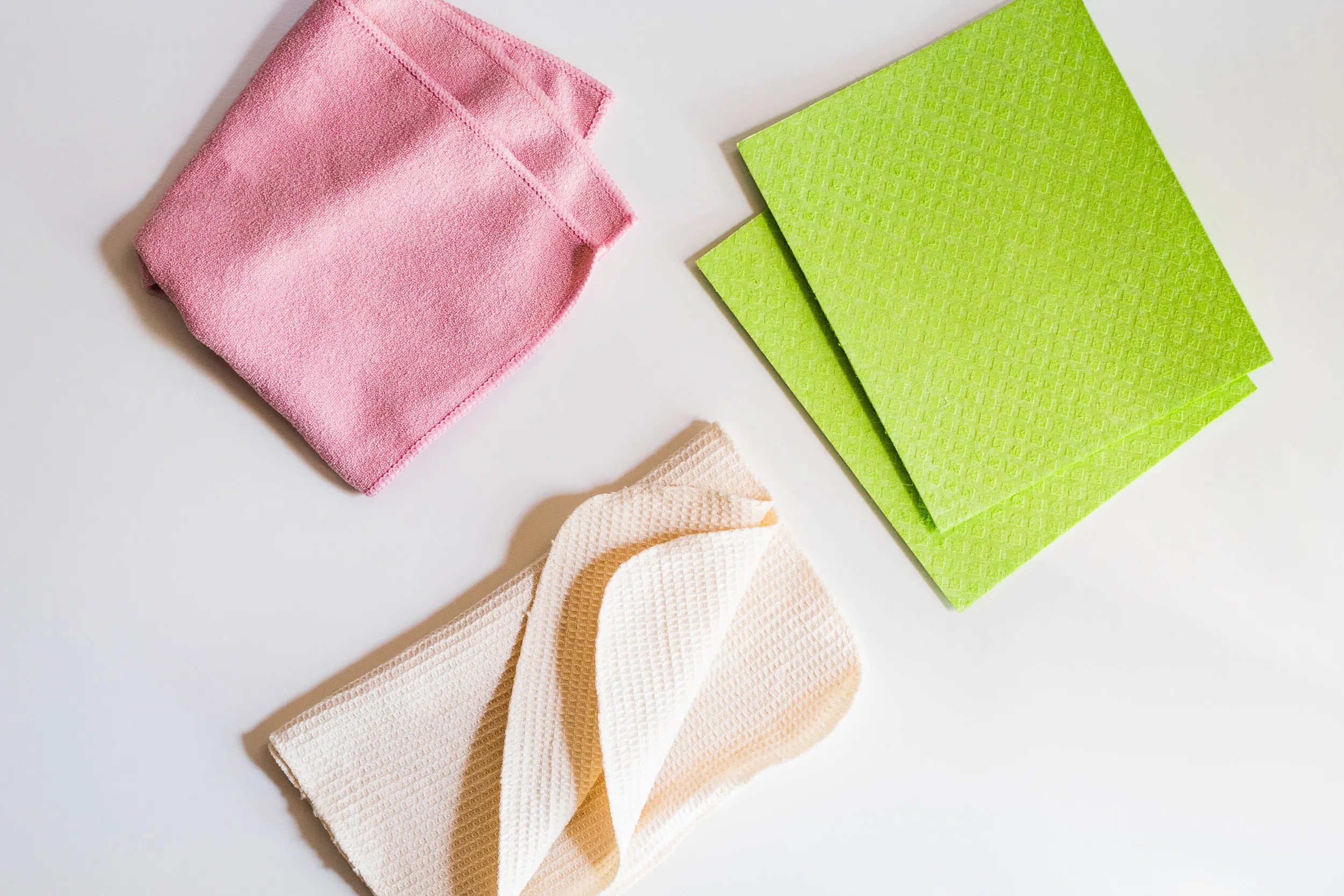Microfiber vs. Cotton Dish Cloths: Which Is Better for Kitchen Cleanup?
Are you tired of scrubbing away at dirty dishes, only to find that your dishcloth is leaving behind streaks and lint? If so, it may be time to consider upgrading your kitchen cleanup routine. When it comes to choosing the perfect dishcloth, two popular options stand out: microfiber and cotton. Both materials have their own unique benefits and drawbacks, making it important to understand which one is best suited for your needs. In this blog post, we'll delve into the world of microfiber vs. cotton dish cloths, exploring their pros and cons as well as offering tips on how to care for them properly. So whether you're a seasoned chef or just starting out in the kitchen, read on to discover which type of dishcloth will revolutionize your cleaning game.
Microfiber Dish Cloths
Microfiber dish cloths have gained popularity in recent years, and it's not hard to see why. These ultra-fine synthetic fibers are designed to provide superior cleaning power without leaving behind any residue or lint. Unlike traditional cotton cloths, microfiber has the ability to trap dirt, grease, and bacteria within its tiny fibers, making it an excellent choice for tackling tough kitchen messes.
One of the main advantages of microfiber is its exceptional absorbency. These cloths can hold up to seven times their weight in liquid, allowing you to efficiently soak up spills or dry dishes with ease. The microscopic size of the fibers also means that they can reach into nooks and crannies that larger cotton fibers might miss.
Microfiber dish cloths are highly durable. They are designed to withstand frequent use and can be washed hundreds of times without losing their effectiveness. This makes them a cost-effective option in the long run compared to disposable paper towels or lower-quality cotton cloths.
Maintenance is a breeze with microfiber dish cloths. Simply toss them in the washing machine with your other laundry using a mild detergent and avoid using fabric softeners as they can reduce absorption capabilities over time. To keep them at peak performance, air drying is recommended instead of using a dryer.
So whether you're wiping down countertops or scrubbing pots and pans, microfiber dish cloths offer an efficient and effective solution for all your kitchen cleanup needs!
Cotton Dish Clothes
When it comes to kitchen cleanup, cotton dish clothes have been a staple for generations. Their soft and absorbent nature makes them perfect for wiping down countertops, drying dishes, and tackling any spills or messes that come your way.
One of the great things about cotton dish clothes is their versatility. They come in a wide range of colors and patterns, allowing you to add a touch of style to your kitchen while getting the job done. Plus, they are gentle enough on delicate surfaces like glassware or non-stick pans.
Another advantage of using cotton dish clothes is their natural ability to soak up liquids effectively. Whether you're dealing with a small spill or a larger mess, these cloths will quickly absorb moisture without leaving streaks behind.
Cotton dish clothes are relatively easy to care for. You can toss them in the washing machine along with your regular laundry load – just be sure not to use fabric softener as it can decrease their absorbency over time.
In terms of drawbacks, one thing that some people may find inconvenient is that cotton dish clothes tend to take longer to dry compared to microfiber ones. This means they might require more frequent replacements if they become too damp or develop an unpleasant odor.
To sum it up, when it comes down to personal preference and specific cleaning needs, both microfiber and cotton dish cloths have their pros and cons. Ultimately though, there's no denying the classic appeal and versatility of good old-fashioned cotton! So why not give it a try next time you're stocking up on kitchen essentials?
Pros and Cons of each type of dish cloth
Microfiber Dish Cloths have gained popularity in recent years due to their superior cleaning abilities. They are made of extremely fine synthetic fibers that can trap dirt and grime effectively. One of the main advantages of microfiber dish cloths is their ability to absorb liquid quickly, making them ideal for wiping up spills or drying dishes.
On the other hand, Cotton Dish Cloths also have their own set of benefits. Cotton is a natural fiber that is soft and gentle on surfaces, making it less likely to scratch delicate items like glassware or non-stick pans. Additionally, cotton dish cloths are known for their durability and long lifespan when cared for properly.
However, there are some drawbacks as well. Microfiber dish cloths can sometimes leave streaks or lint behind if not used correctly or washed regularly. On the flip side, cotton dish cloths may not be as effective in picking up small particles due to their larger fibers.
When it comes to different types of cleanup tasks, microfiber dish cloths excel at removing grease and stubborn stains thanks to their excellent absorption capabilities. They are also great for dusting surfaces without leaving any residue behind.
Cotton dish cloths, on the other hand, are perfect for general cleaning tasks such as wiping down countertops or drying dishes after washing them by hand.
To ensure longevity and effectiveness of both types of dish cloths, proper care is crucial. Microfiber should be washed separately from lint-producing materials like towels or clothing items using mild detergent and no fabric softener. Cotton should be machine-washed with similar colors using hot water and dried thoroughly before storing.
Both microfiber and cotton dishcloths have their pros and cons depending on your specific needs. Consider factors such as cleaning power requirements, surface sensitivity concerns, and personal preferences when choosing between these two options!
Which is better for different types of cleanup?
Different types of cleanup require different tools, and this is no exception when it comes to dish cloths. Whether you're dealing with stubborn grease or delicate glassware, choosing the right type of cloth can make all the difference in achieving a sparkling clean kitchen.
For tough and greasy messes, microfiber dish cloths are often the go-to choice. Their ultra-absorbent properties allow them to effectively trap dirt and grime, making them ideal for wiping down countertops and stovetops. The fine fibers also enable microfiber cloths to reach into crevices and corners that cotton cloths may struggle to access.
On the other hand, cotton dish cloths excel at more delicate tasks. Their soft texture makes them suitable for gently drying fragile dishes or wiping down sensitive surfaces like glassware or crystal. Cotton is also naturally non-abrasive, reducing the risk of scratching delicate items.
When it comes to cleaning appliances such as stainless steel ovens or microwaves, both microfiber and cotton have their merits. Microfiber's ability to attract dust particles makes it great for removing fingerprints from stainless steel surfaces without leaving streaks behind. Meanwhile, cotton's absorbency allows it to soak up spills quickly.
Which type of cloth is better for different types of cleanup depends on your specific needs and preferences. Consider factors such as surface material, level of dirtiness, and sensitivity before deciding which cloth will give you the best results.
In terms of versatility though, microfiber takes the lead due to its ability to tackle various cleaning tasks effectively - from heavy-duty scrubbing to light dusting. However, if you prioritize softness over versatility in certain situations where delicacy matters most –such as polishing silverware– then a high-quality cotton cloth might be your preferred option.
Remember that regardless of which type you choose for each task; proper care is essential in maintaining their effectiveness over time.
How to care for your dish cloths
When it comes to keeping our kitchens clean, dish cloths play a vital role. Whether you prefer microfiber or cotton dish cloths, proper care is essential to ensure their longevity and effectiveness. Here are some tips on how to care for your dish cloths:
1. Wash them regularly: Dish cloths can harbor bacteria and odors if not washed frequently. It's recommended to wash them after each use or at least every couple of days.
2. Separate from other laundry: To prevent cross-contamination, wash your dish cloths separately from other laundry items, especially clothing that may have stains or strong odors.
3. Use hot water and detergent: Hot water helps kill germs and removes grease effectively. Use a good quality detergent that can break down oils and food particles.
4. Avoid fabric softeners: Fabric softeners can leave residue on the fibers of your dish cloth, reducing its absorbency over time. Instead, add a small amount of vinegar during the rinse cycle as a natural fabric softener alternative.
5. Air dry whenever possible: Hang your dish cloths in a well-ventilated area to allow them to air dry completely before using them again. This helps prevent moisture buildup that could lead to bacterial growth.
6.Store properly: After washing and drying your dish cloths, store them in a clean and dry place away from moisture sources like sinks or countertops.
By following these simple tips, you can keep both microfiber and cotton dish cloths in excellent condition for longer-lasting performance in tackling kitchen cleanup tasks!
After weighing the pros and cons of both microfiber and cotton dish cloths, it is clear that each type has its own advantages. Microfiber dish cloths are excellent for tackling tough stains and absorbing moisture quickly, while cotton dish cloths are more versatile and gentle on delicate surfaces.
If you're looking for a cloth that can handle heavy-duty cleaning tasks in your kitchen, microfiber is the way to go. Its ultra-absorbent properties make it great for wiping up spills or drying dishes efficiently. Additionally, their ability to attract dust makes them useful for other household cleaning tasks as well.
On the other hand, if you prefer a softer touch or have sensitive surfaces in your kitchen, cotton dish cloths are an excellent choice. They provide a gentle yet effective clean without scratching or damaging delicate items like glassware or non-stick pans.
When it comes to choosing between microfiber and cotton dish cloths for different types of cleanup, consider the specific needs of your kitchen. For everyday use and general wiping tasks, both options will work well. However, if you frequently encounter stubborn stains or need quick-drying capabilities, microfiber may be more suitable.
It's important to note that regardless of which type of cloth you choose; proper care is essential to maintain their effectiveness over time. Always wash them separately from heavily soiled items using mild detergent and avoid using fabric softeners as they can reduce absorbency.
When deciding between microfiber vs. cotton dish cloths for your kitchen cleanup needs, consider factors such as cleaning power requirements and surface sensitivities before making your final decision. Both options have their merits depending on what exactly you're looking for in terms of functionality and convenience.
Frequently Asked Questions (FAQs)
Can I use microfiber dish cloths for cleaning glass surfaces?
Yes, microfiber dish cloths are excellent for cleaning glass surfaces as they leave no streaks or lint.
Are cotton dish cloths suitable for cleaning greasy surfaces?
Yes, cotton dish cloths can effectively clean greasy surfaces, but they may require more effort compared to microfiber cloths.
How can I prevent odor retention in microfiber dish cloths?
To prevent odor, rinse and wring out microfiber cloths thoroughly after each use and allow them to dry completely.
Can I use cotton dish cloths for drying dishes?
Yes, cotton dish cloths can be used for drying dishes, but they may not be as efficient at absorbing water as microfiber cloths.
Which material is more eco-friendly: microfiber or cotton?
Cotton is considered a more eco-friendly option as it is a natural, biodegradable material. However, microfiber can be made from recycled materials, which can also be eco-friendly depending on the manufacturing process.


